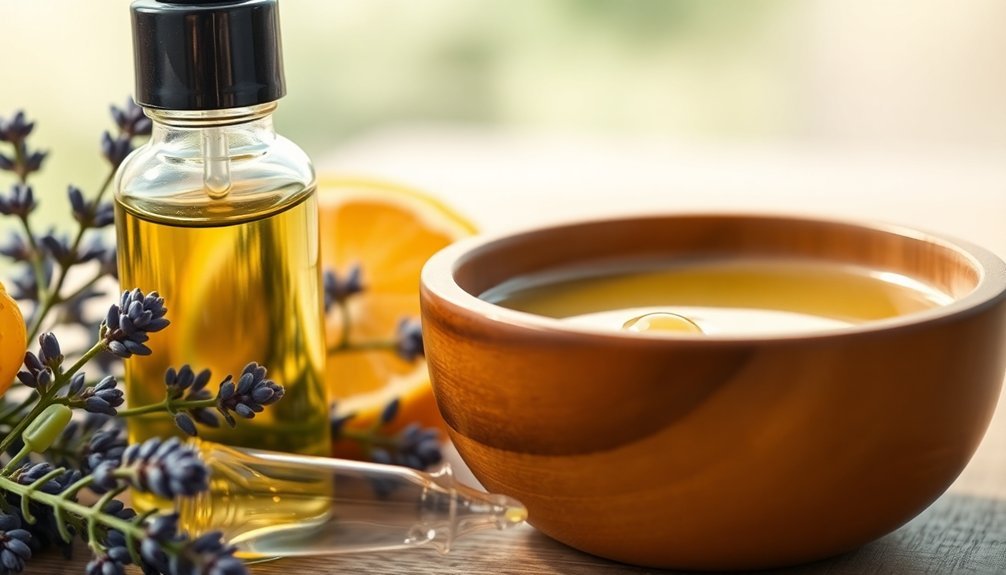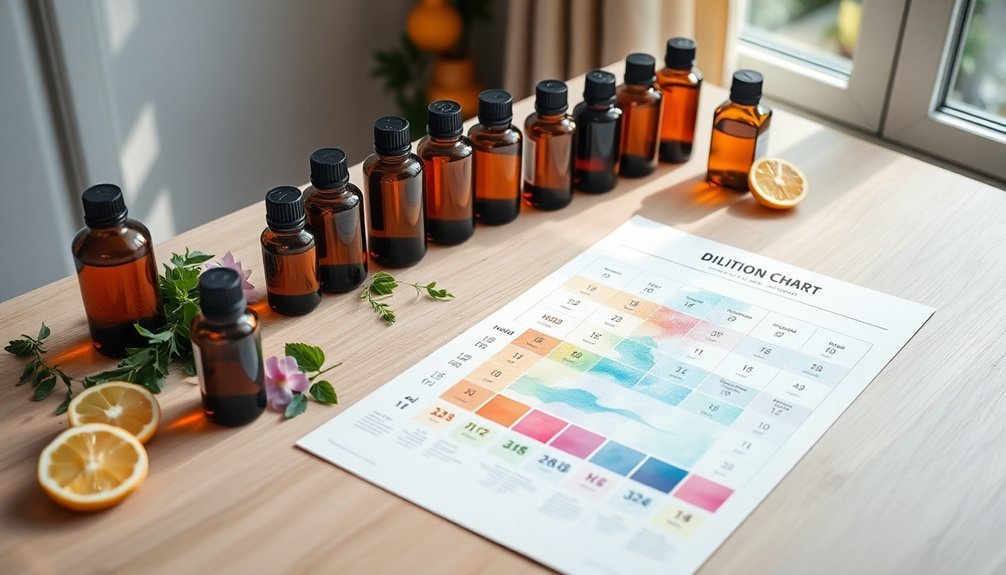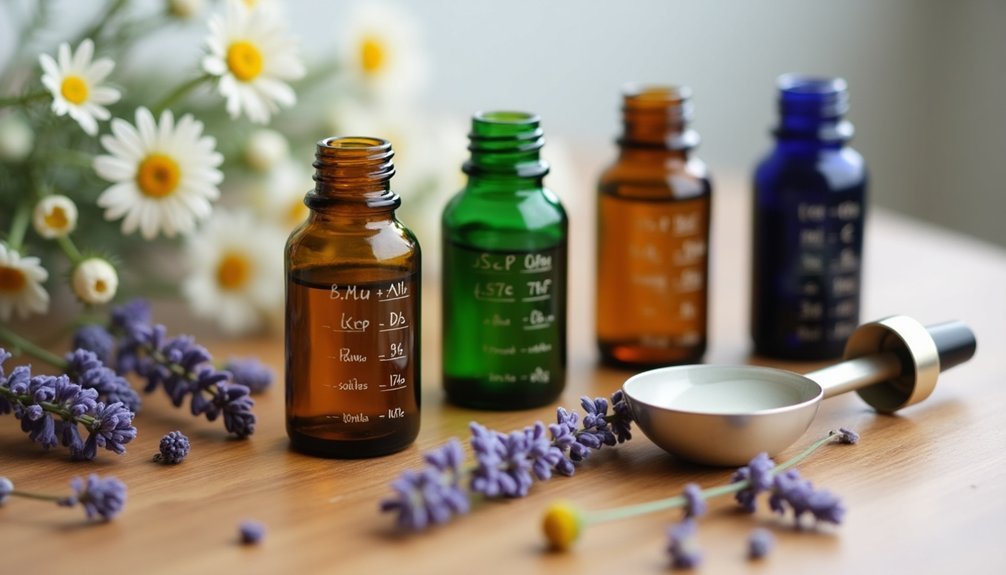Keep essential oils safe by following these key dilution rules: Always dilute oils to 2-3% for adults (12-18 drops per ounce of carrier oil) and 1% for children. Choose appropriate carrier oils for your blend's purpose. Use dark glass bottles and store in cool, dark places. Test patches on skin before full application. Measure precisely using droppers or pipettes. Don't apply to damaged skin. Clean hands after handling. These fundamentals will open the door to creating effective, personalized blends.
Understanding Essential Oil Dilution Percentages

When working with essential oils, understanding proper dilution percentages is crucial for both safety and effectiveness.
For most adults, you'll want to stick to a 2-3% dilution, which means using 12-18 drops of essential oil per ounce of carrier oil. If you're creating products for children or elderly individuals, reduce that to a 1% dilution due to their more sensitive skin.
While you can use higher concentrations (up to 10%) for targeted areas, it's best to follow the general rule of not exceeding 2% for most body care formulations.
You'll need to adjust these percentages based on specific factors, including the type of essential oil you're using, your health status, and your intended purpose.
Remember that some oils, like clove bud and holy basil, require even lower dilutions for safe use. Professional aromatherapists strongly advise against using neat application of essential oils directly on the skin to prevent irritation and sensitization.
Selecting the Right Carrier Oil for Your Blend
Selecting the right carrier oil serves as the foundation for any successful aromatherapy blend. When choosing your carrier oil, you'll need to take into account both your specific needs and the properties of different oils.
While some carriers like sweet almond oil offer general-purpose benefits, others provide unique therapeutic advantages for specific conditions. For optimal skin benefits, look for oils that are cold pressed rather than heat-extracted to maintain their natural properties.
To choose the most suitable carrier oil for your blend:
- Determine your blend's purpose – whether it's for massage, skincare, or therapeutic use.
- Take into account the application area and your skin type to avoid potential irritation.
- Check the oil's shelf life to guarantee your blend remains stable.
- Evaluate the oil's natural aroma to complement your essential oils.
Don't hesitate to blend multiple carrier oils to create a customized base that combines their beneficial properties while optimizing the final product's effectiveness.
Basic Measurements and Mixing Techniques

Three fundamental principles guide accurate aromatherapy measurements and mixing: precise dilution ratios, consistent measuring methods, and proper blending techniques. You'll need to understand that drops can vary in size, so using a conversion chart helps maintain accuracy. For proper measurements, use a glass pipette or dropper to ensure precise dosing. For most personal blends, count your drops carefully and aim for a 2% dilution by adding 12 drops of essential oil to one fluid ounce of carrier oil.
| Dilution % | Drops per 1 oz | Best Uses |
|---|---|---|
| 0.5% | 3 drops | Facial care, children |
| 1% | 6 drops | Pregnancy, elderly |
| 2% | 12 drops | General body care |
| 3% | 18 drops | Massage, hair care |
Remember to measure your carrier oil first, then add essential oils drop by drop, gently swirling to blend. Always start with a lower dilution and adjust as needed.
Proper Storage and Labeling of Diluted Oils
To preserve the therapeutic properties of your diluted essential oils, proper storage and labeling practices are crucial. Always store your dilutions in dark glass bottles, keeping them in a cool, dark place away from direct sunlight and heat sources. A consistent room temperature of around 72°F is ideal, and you'll want to avoid storing oils in bathrooms or cars where temperatures fluctuate.
Your labels should include:
- Product name and brand identity
- Net quantity in metric measurements
- Complete ingredient list in order of predominance
- Warning statements and safety precautions
Don't forget to tightly close the caps after each use to prevent oxidation.
While freezer storage is an option, some oils may solidify and need thawing before use. For retail purposes, make sure your labels comply with FDA guidelines and include batch numbers, manufacturing dates, and expiration dates.
Safety Guidelines for Skin Application

When applying essential oils to your skin, proper dilution serves as your first line of defense against adverse reactions and irritation.
You'll need to dilute oils between 1% and 5% for adults, while children require lower concentrations of 0.5% to 2.5%. Remember that a 1% dilution equals about 5-6 drops per ounce of carrier oil.
Don't apply essential oils directly to damaged or inflamed skin, as it's more permeable and sensitive. Always perform a patch test first, and wash your hands after handling oils to prevent accidental eye contact.
If you're using photosensitizing oils like citrus varieties, avoid sun exposure to prevent burns. Be especially cautious with potent oils such as wintergreen, birch, and peppermint, which require higher dilution ratios.
For elderly clients and children, use reduced concentrations due to their increased skin sensitivity.
Special Considerations for Different Skin Types
Different skin types require specific approaches to aromatherapy oil dilution, building upon the general safety guidelines already discussed.
If you have sensitive skin, stick to a 1% dilution rate, especially for facial applications. For normal skin types, you can safely use a 2-3% dilution with your chosen carrier oil.
When working with special populations or skin conditions, follow these essential guidelines:
- Children's skin needs extra care – use only 1% dilution and child-safe essential oils.
- Elderly or fragile skin requires gentle 1% dilutions with nutrient-rich carrier oils.
- Normal skin can handle 2-3% dilution for body applications and DIY products.
- Sensitive skin should start with 1% dilution, gradually testing tolerance levels.
Always choose carrier oils like jojoba or sweet almond that complement your skin type and intended use.
Essential Oil Dilution Charts and Ratios

When mixing essential oils, you'll need to follow standard dilution ratios of 1-2% for most applications, which means using 1-2 drops of essential oil per teaspoon of carrier oil.
You'll want to increase the concentration to 3% for targeted treatments while keeping facial applications at a lower 0.2-1.5% dilution rate.
For safe blending, you should always measure precisely using drops or measuring spoons, and remember to label your mixtures with ingredients and creation dates.
Standard Dilution Quick Guide
A thorough understanding of essential oil dilution ratios forms the foundation of safe aromatherapy practice.
You'll need to adjust your dilution rates based on who's using the oils and how they're being applied.
For quick reference, follow these standard dilution guidelines:
- Use a 1% dilution (3-6 drops per 10ml carrier oil) for facial applications, children over 2, and elderly individuals.
- Apply a 2% dilution (12-18 drops per 30ml carrier oil) for adult body care and general massage.
- Keep it minimal for babies under 2 years with 0.25-0.5% dilution (1-2 drops per 2 tablespoons carrier oil).
- Remember that 100 drops equals 5ml (1 teaspoon), which helps you calculate proper measurements for larger batches.
Always start with a lower dilution if you're unsure about sensitivity.
Advanced Mixing Safety Tips
Building on these foundational dilution guidelines, mastering advanced mixing techniques requires a deeper grasp of dilution charts and safety protocols.
You'll need to take into account that different charts may use varying drop counts per milliliter, which can affect your measurements considerably.
When mixing essential oils, always err on the side of using less rather than more, especially for sensitive populations.
If you're creating solutions with water or alcohol-based mediums, you'll need to incorporate emulsifiers to maintain stability.
Don't forget to shake these mixtures before each use.
Before applying any new blend, perform a patch test to check for adverse reactions.
Remember to adjust your dilution ratios based on individual factors like age, skin sensitivity, and existing health conditions or medications.
Frequently Asked Questions
Can I Mix Different Essential Oils in the Same Carrier Oil Blend?
Yes, you can mix different essential oils in the same carrier oil blend, but you'll need to guarantee the total essential oil concentration stays within safe dilution ranges and the oils are compatible with each other.
How Long Do Properly Diluted Essential Oil Mixtures Typically Last?
Your properly diluted essential oil mixtures will typically last 3-6 months when stored correctly. You'll want to replace them sooner if you notice any changes in smell, color, or texture.
Should Essential Oil Dilutions Be Adjusted Based on Seasonal Weather Changes?
Yes, you'll need to adjust your essential oil dilutions based on seasonal changes. During dry winter months, use higher dilution ratios, while in humid summer conditions, you can maintain standard dilution levels.
Can I Use Water Instead of Carrier Oils for Dilution?
No, you shouldn't use water to dilute essential oils. They won't mix properly since oil and water don't combine. You'll need a proper carrier oil or emulsifier to guarantee safe, effective dilution.
What Happens if I Accidentally Use Expired Carrier Oil for Dilution?
If you've used expired carrier oil, you'll risk skin irritation, allergic reactions, and reduced effectiveness of your essential oils. Stop using it immediately and watch for any adverse reactions like redness or itching.
In Summary
You've now learned the essential rules for safely diluting aromatherapy oils. With these guidelines, you'll be able to create properly balanced blends that are both effective and gentle on your skin. Remember to always measure carefully, choose the right carrier oil, and store your mixtures correctly. Don't skip the dilution process – it's vital for preventing skin reactions and getting the most from your essential oils.





Leave a Reply